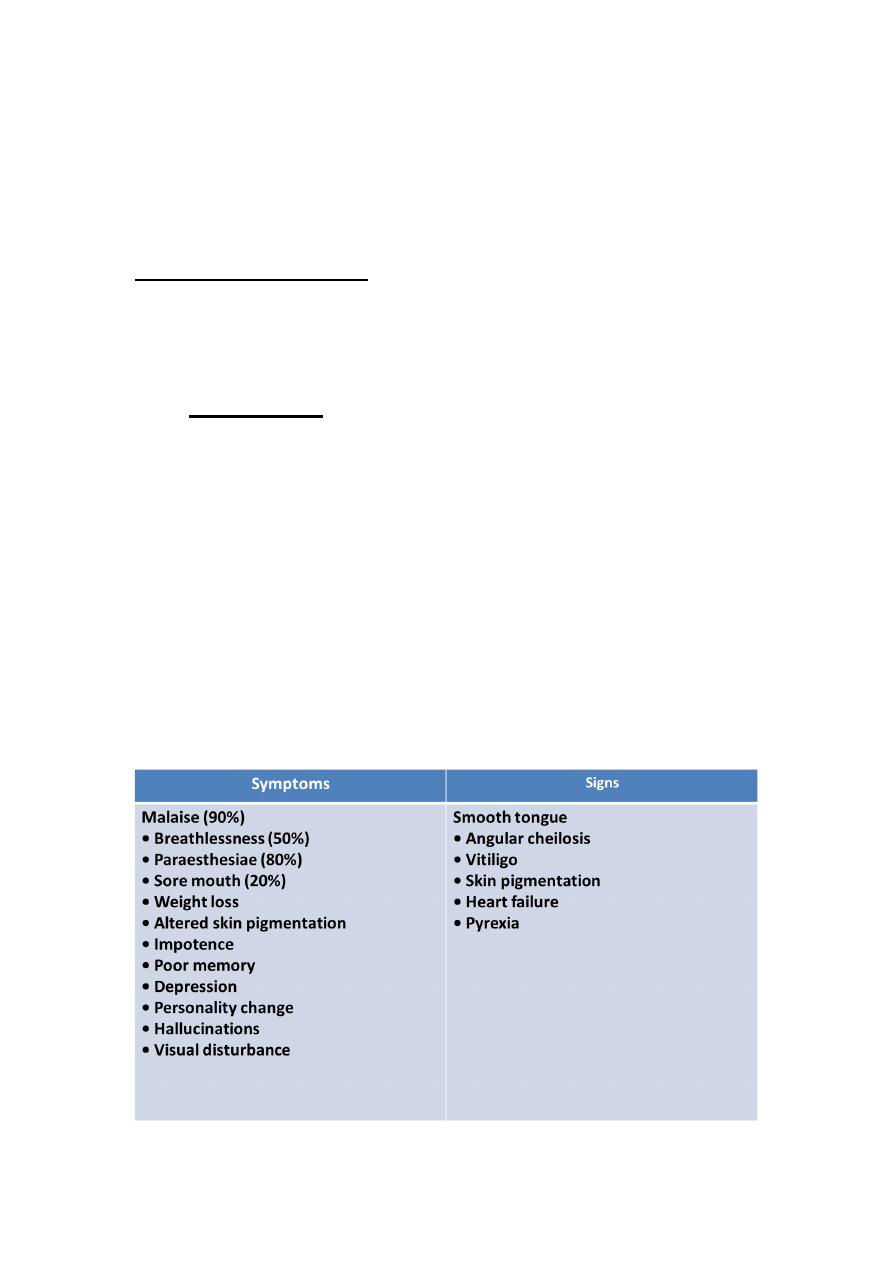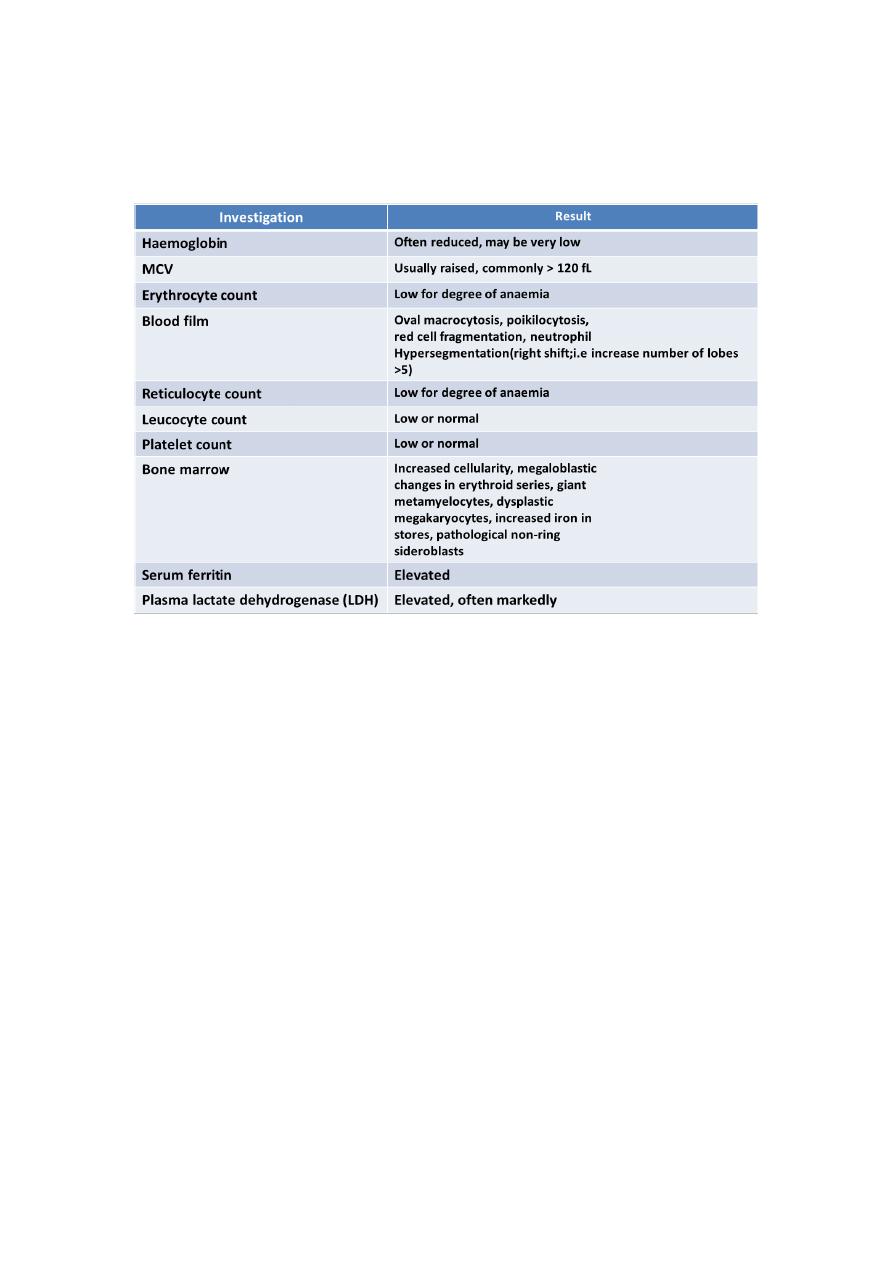
Fifth stage
Medicine
Lec-3
د.خالد نافع
27/10/2015
Megaloblastic Anaemia
Definition : Megaloblastic anaemia are group of disorder
characterized by the presence of distinctive morphological
appearance of developing RBC in the BM leading to
macrocytic anaemia and pancytopenia;
this abnormality affect all cells that have a rapid turnover : GIT
mucosal cells,gonads and epidermal cells ,hence changes are
evident; in the buccal mucosa, tongue, small intestine,
cervix,vagina and uterus.,
*Ineffective erythropoiesis;Bone marrow.
*Megaloblastic anaemia is the result of abnormal DNA
synthesis because of a single or combined deficiency of Folate,
vitamin B12.
*Folate is an important substrate of, and vitamin B12 a co-
factor for, the generation of the essential amino acid
methionine from homocysteine
Effect of Vit B12 on folate
• demethylation of folate that has been taken by the cells,
allowing it to be conjugated (supplied with
polyglutamates )
• vit. B12 deficiency prevents the cells from retaining folate,
with following consequences :
• elevated levels of 5-methyl tetra hydro folate (5-mTHF).
• decrease level of intracellular polyglutamate folate caused
by increased leakage of solute from the cells.

Megaloblastic Anaemia
Deficiency of either vitamin B12 or folate will therefore produce
high plasma levels of homocysteine and impaired DNA
synthesis
• Vitamin B12 :
• A cobalt containing vitamin.
• Found primarily in foods containing animal protein such as
meat, fish eggs , milk.
• The normal daily requirements is 1 μg daily
• About 2-5 mg are stored in the liver, means that vitamin
B12 deficiency takes years to develop.
Clinical features of megaloblastic anaemia

Neurological findings in B12 deficiency
Peripheral nerves
• Glove and stocking paraesthesiae
• Loss of ankle reflexes
Spinal cord
• Subacute combined degeneration of the cord
Posterior columns – diminished vibration sensation and
proprioception
Corticospinal tracts – upper motor neuron signs
Cerebrum
• Dementia
• Optic atrophy
Autonomic neuropathy
Causes of vit. B12
Depletion by decreased diet intake (vegans & vegetarians
)
Poor absorption :absence of IF as in pernicions anaemia,
gastrectomy and infiltration of stomach (lymphoma , Ca)
.
increased bacterial utilization of vit. B12
.
gastrointestinal bypass surgery
.
Small bowel diverticula
.
Intestinal stasis & obstruction
.

Parasitic infestation
.
Fish tape worm (diphyllobotherium latum
)
Pathology in absorption sites
TB of the ileum
.
Lymphoma of the small intestine
.
Tropical sprue
.
Regional enteritis
.
Pernicious Anaemia (PA)
• Etiology : PA a consequence of long standing gastritis
lead to atrophy of all the cells of the stomach
(secretory).
• Auto-immue mechanism :
• Anti-intrinsic factor( IF) antibody( Ab.) found in 75% of
pt. With PA. IgG or IgM found in saliva ,gastric juice,
serum.
• Other antibodies
• Anti-parietal cell Abs.
• Lymphocytic infiltration of gastric mucosa.
In the absence of intrinsic factor, less than 1% of dietary
vitamin B12 is absorbed.
Pernicious anaemia has an incidence of 25/100 000
population over the age of 40 years in
developed countries,
but an average age of onset of 60 years.
It is more common in individuals with other autoimmune
disease (Hashimoto’s thyroiditis, Graves’
disease, vitiligo, hypoparathyroidism or Addison’s disease)

Investigations in megaloblastic anaemia
Folate
Folates are produced by plants and bacteria; hence
dietary leafy vegetables (spinach, broccoli, lettuce),
(kidney,
fruits (bananas, melons) and animal protein
(
liver
(pteroyl-glutamate)
folic acid
1.
total body folate is 10 mg in liver, daily requirement
100
µg.
2. Stores is sufficient for 4 month.
Causes of folate deficiency
Diet
• Poor intake of vegetables

Malabsorption
• e.g. Coeliac disease
Increased demand
• Cell proliferation, e.g. haemolysis
• Pregnancy
Drugs
*
• Certain anticonvulsants (e.g. phenytoin)
•
• Contraceptive pill
• Certain cytotoxic drugs (e.g. methotrexate)
*Usually only a problem in patients deficient in folate from
another cause
Regional enteritis.
Investigation of folic acid deficiency
Diagnostic findings
• Serum folate levels may be low but are difficult to interpret
• Low red cell folate levels indicate prolonged folate
deficiency
and are probably the most relevant measure
Corroborative findings
• Macrocytic dysplastic blood picture
• Megaloblastic marrow
Management of megaloblastic
anaemia
Blood transfusions should be avoided , since circulatory
overload may result. However if transfusion is needed to
treat anoxia 1 or 2 units of packed cells can be administered

slowly with concurrent administration of diuretics or
phlebotomy on the other arm.
The severely anaemic pt. who urgently needs
therapy but whose vit deficiency is not clearly
known should be given both folate & vit. B12. If this
patient receive folate for what is actually a vit. B12
deficiency neurological abnormalities may
precipitate and worsen.
Deficiency
12
Treatment of Vit B
Vitamin B12 deficiency is treated with hydroxycobalamin
1000 μg IM for 6 doses 2 or 3 days apart, followed by
maintenance therapy of 1000 μg every 3 months
for life.
Elderly pts with heart failure : should receive diuretics and
oral potassium supplements for 10 days to prepare for
Potential hypokalaemia.
The reticulocyte count will peak by the 5th–10th day
after starting replacement therapy. The haemoglobin
will rise by 10 g/L every week until normalised .
A sensory neuropathy may take 6–12 months to correct; long-
standing neurological damage may not improve.
TREATMENT OF Folate deficiency
Oral folic acid 5 mg daily for 3 weeks for acute
deficiency
5 mg once weekly is adequate maintenance
Prophylactic folic acid in pregnancy prevents megaloblastosis in
women at risk, and reduces the risk of fetal neural tube defects

Supplementation Prophylactic is also given in chronic
haematological
disease associated with reduced red cell lifespan
(e.g.haemolytic anaemias)..
